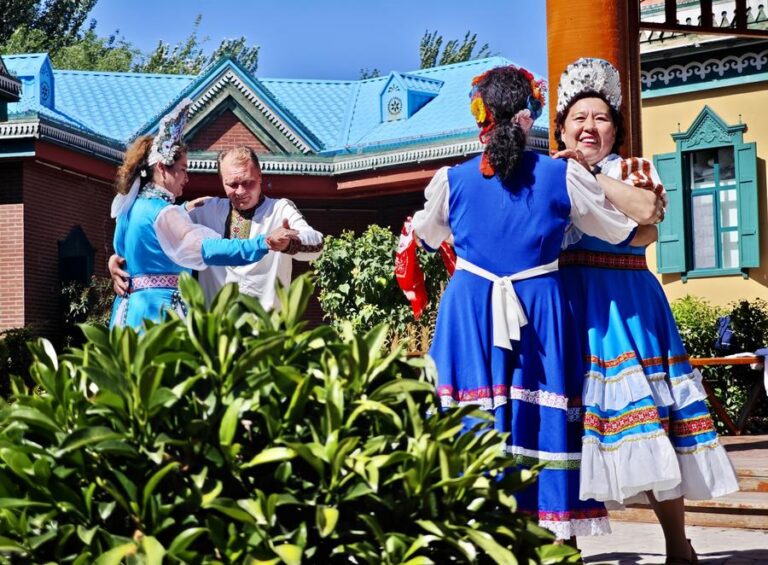Ethnic Russian residents perform a folk dance on Liuxing Street in Yining city, Ili Kazakh Autonomous Prefecture, northwest China’s Xinjiang Uygur Autonomous Region, May 28, 2024. (Xinhua/Wang Fei)
URUMQI, June 1 (Xinhua) — Strolling along the historic Liuxing Street, tourists are greeted by the sweaty sounds of traditional folk songs, joyous dance performances by locals and the aroma of freshly baked bread.
Located in Yining city, Ili Kazakh Autonomous Prefecture, Xinjiang Uygur Autonomous Region in northwest China, Liuxing Street features a unique hexagonal layout that was designed by German engineers and built in the mid-1930s.
Over the past century, people of various ethnic groups, including Han, Kazakh, Hui, Uighur, Russian and Tatar, have coexisted here, and the area is currently home to over 3,000 people.
In 2014, the local government allocated an investment of 30 million yuan (about US$4.2 million) to launch the old street protection and renovation project. Five years later, another 130 million yuan has been pumped into preserving and restoring Liuxing Street, and the city’s cultural and tourism department has invested more than 50 million yuan to promote tourism development in 2022, said Ma Liying, general manager of the tourism company in charge of the operation and management of the Liuxing Street scenic spot.
Today, the old town has been transformed into an ethno-cultural area with a focus on historical architecture, traditional folk crafts, music and art.
“In recent years, we have seen an increase in tourists from all over the country as well as foreign tourists,” Ma said, adding that they come here to experience the blend of multiple ethnic communities.
The surge in tourism has also benefited the local economy: During this year’s May Day holiday, 692,700 domestic tourists visited Yining, up 27.55 percent from last year, bringing in tourism revenue of 433 million yuan, up 59.88 percent from the previous year.
Today, the street’s scenic spots are home to more than 300 guesthouses, restaurants, handicraft shops, hotels and specialty stores, which employ more than 1,100 local people, of which 890 are from various ethnic groups.
In the first quarter of 2024 alone, 21 new companies were established, creating more than 50 new jobs.
Tourists enjoy a performance at the Accordion Museum on Liuxing Street in Yining city, Ili Kazakh Autonomous Prefecture, northwest China’s Xinjiang Uygur Autonomous Region, May 28, 2024. (Xinhua/Wang Fei)
Zhang Xinyu, who opened the guesthouse in August 2021, currently operates 14 rooms and serves meals, coffee and wine on the first floor. The guesthouse employs 10 staff members from diverse ethnic backgrounds.
Services such as car rental, travel photography and customized itinerary planning are also offered to tourists.
Zhang said that last year her guesthouse attracted about 3,000 tourists, including those from Kazakhstan, Britain, the United States, Germany and Japan, and generated revenue of about 3 million yuan.
“The Belt and Road Initiative has attracted more tourists and investors to Yili, boosting tourism and economic development. Moreover, by promoting the Silk Road culture, it has helped more people understand Xinjiang, which has made great contributions to Xinjiang’s economic development,” Zhang said.
“I really like the cozy neighborhood and enthusiastic residents here in Liuxing Street. I hope to come back and take my family to explore the vast beauty of Xinjiang,” said Sun Li, a tourist from Shanghai, who chose to travel around the region by train with her daughter in search of a fresh and different experience.
“Yining has greatly benefited from the improved transportation access connecting inland regions, especially with the opening of new air and railway lines. Tourists’ travel options have been diversified, especially with the introduction of tourist trains, which have made positive contributions to the development of Xinjiang’s trade, logistics and tourism industries,” Ma said.
As part of a push to boost tourism, Xinjiang’s railway sector has been working to improve services over the years, with 106 tourist trains scheduled to run this year. As of May 30, 27 trains had already been successfully operated, according to China Railway Urumqi Group Co., Ltd.
Xinjiang’s tourism development has shown strong momentum in recent years, with the number of tourists visiting Xinjiang expected to reach 265 million by 2023, an increase of 117%, and tourism revenue expected to reach 296.7 billion yuan, an increase of 227%.

